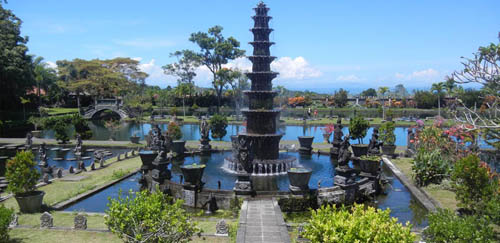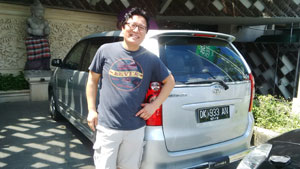Tirta Gangga Bali Tourist Destination
5 March 2012Approaching from the south along the coast beyond Klungkung, the traffic thins and the pace slows as the main road finally meets Baliís east coast. Undulating irrigated rice fields give way to the sunís blazing heat on this arid stretch of road which passes fishing villages, beach side salt processing factories, the old harbor of Kusamba and the holy bat cave of Goa Lawah.
 Just before entering the bridge at the entrance of Amlapura, the capital of Karangasem Regency, a left hand turn takes you seven kilometres northwest to large pool complexes in all of Bali. Perfect for relaxation, Tirtagangga, meaning literally ĎWater of the Ganges, was built by the last raja of Karangasem, Raja Anak Agung Anglurah Ketut, in 1947 with curve labor on the site of a sacred spring emerging from under an ancient banyan tree.
Just before entering the bridge at the entrance of Amlapura, the capital of Karangasem Regency, a left hand turn takes you seven kilometres northwest to large pool complexes in all of Bali. Perfect for relaxation, Tirtagangga, meaning literally ĎWater of the Ganges, was built by the last raja of Karangasem, Raja Anak Agung Anglurah Ketut, in 1947 with curve labor on the site of a sacred spring emerging from under an ancient banyan tree.
These formal, Italianate-style water gardens were only one weekend retreats of the old raja, who seemed to been prone towards a water fetish; the others lie at .Jungutan and Ujung (considered his masterpiece). With its ornate fountains, shallow pools and channels, bizarre statues, pleasant cool weather (500 meters above sea level), great beauty, quiet star-filled nights and the constant sound of splashing water, itís a sublime experience to swim laps in big flowers-strewn reservoirs filled by freshwater mountain streams. Although open 24 hours every day, the ticket is open from 7 a.m. to 6 p.m. Pools are drained on Monday mornings, but are completely filled again afternoon. The water is spine-tinglingly cold, so wait until noon to plunge in. After 6 p.m., the water is too cold.
VICINITY OF TIRTAGANGGA
With Baliís biggest and most sacred mountain towering above, this whole area has fantastic scenery. Climb the hill behind the water palace, following the water source of the pools, for about 1 .5 kilometers to a small village, then walk back via a winding road through the valley by coconut groves, brilliant rice fields and the distant sea beyond. Take binoculars. Another superlative walk is the path leading uphill to the villages of Tanahlingis and Ababi.
Three kilometers west of Tirtagangga is Puncak Sari with a panorama over rice fields. The 92-kilometres three-hour run to Singaraja takes you through a sparsely populated area which lends itself to dramatic photographs. Just before Culik thereís an explosion of vegetation - you can smell it coming. After Culik, not much grows except Poinciana, stunted palm trees, kapok and cacti.
For Bukit Lempuyang, the site of an important temple on Baliís easternmost hill, drive to the parking lot about halfway up. About eight kilometres from the main highway (see signs pointing the way to the temple) is a tollgate; from where the road ends, itís about a one kilometer walk to the first small temple, Pura Telagamas at 768 meters. From there itís 4,000 steps to Pura Lempuyang (1058 meters) or to the top of Mount Serayu (1175 metres) through a forest. Start early, before it gets too hot. If you go in the afternoon, the mountain is covered in clouds. On clearer mornings youíll see not only Mount Agung but all the way to the islands of Nusa Penida and Lernbongan. This is one of nine major sad kayangan spiritual points on Bali, right up there in stature with Ulu Watu and Besakih.
BALIíS LOST COAST
The highlight of this whole area is the undeveloped coastal strip northeast of Tirtagangga. In the Amed area you can finally find peace and quiet, enjoy simple but delicious food, inexpensive accommodation, unobtrusive massage ladies, few hawkers, just one or two boat trip guys who leave you alone after asking a couple of times.
The area offers some of Baliís best snorkeling, the islandís most splendidly located self-contained dive Iosmen and home stays, quiet unpeopled beaches, and Baliís largest concentration of traditional fishing jukung. Snorkeling off the black-sand beaches here is considered by some to be superior to Tulamben, the variety and numbers of fish perhaps the best on Bali. The snorkeling begins just east of town where the currents are calm year-round visibility is 10-20 meters and the hard coastal reefs superb. Dive along the reef wall to see schools of cardinal fish, triggerfish, black snappers, pyramid butterflies, banner fish and damsel fish among the sand slopes, table corals, big fan gorgonians, and magnificent stag horn Acroporaand Dendronephthyatrees, dense growths of sponges, crinoids, and sea fans - all within 20 meters of the shore.
Bali Best Quote
Why rent a car in Bali?
- Bali Car Rental Self drive with wide range of well maintained fleet
- Rent a car with Bali tour driver
- Bali Car charter, price already included car, Bali tour driver and petrol. Our tour driver will be happy to drive for you as per your own itinerary in Bali Island.


| For mor information please feel free to contact Rent Car Bali.net | |
| Hotline | local 085737187321 |
| overseas: +62 85737187321 | |
| 6285737187321 | |















